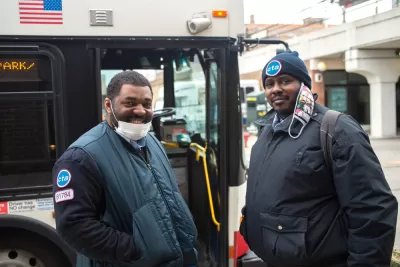A new online tool aims to help transit agencies recruit and retain workers.

A new online dashboard from the Transit Workforce Center compiles a wealth of data about public transit workforces as part of an effort to help agencies attract and retain workers. “The dashboard creates a one-stop shop for ‘visualizations and digestible information about the transit workforce’ that will be continually updated, the Transit Workforce Center said.”
As Dan Zukowski explains in Smart Cities Dive, since the beginning of the pandemic, working conditions have worsened dramatically for many transit operators. “Existing skilled workers are leaving transit jobs, frustrated by inflexible schedules, low wages and few opportunities for professional growth. Physical attacks on bus drivers became more common beginning in the 2010s and increased at the start of the pandemic.”
Zukowski adds that “TWC projects that 13.2% of bus drivers will leave the role each year from 2021 to 2031. By 2030, transit and intercity bus systems will have to fill 233,000 bus operator positions, with 220,000 of those hires needed to replace drivers who leave or retire.” The dashboard is designed to provide a nationwide directory of information and help agencies illustrate the benefits of working in public transit.
FULL STORY: New transit workforce dashboard can help agencies tackle labor shortages

Alabama: Trump Terminates Settlements for Black Communities Harmed By Raw Sewage
Trump deemed the landmark civil rights agreement “illegal DEI and environmental justice policy.”

Study: Maui’s Plan to Convert Vacation Rentals to Long-Term Housing Could Cause Nearly $1 Billion Economic Loss
The plan would reduce visitor accommodation by 25% resulting in 1,900 jobs lost.

Why Should We Subsidize Public Transportation?
Many public transit agencies face financial stress due to rising costs, declining fare revenue, and declining subsidies. Transit advocates must provide a strong business case for increasing public transit funding.

Paris Bike Boom Leads to Steep Drop in Air Pollution
The French city’s air quality has improved dramatically in the past 20 years, coinciding with a growth in cycling.

Why Housing Costs More to Build in California Than in Texas
Hard costs like labor and materials combined with ‘soft’ costs such as permitting make building in the San Francisco Bay Area almost three times as costly as in Texas cities.

San Diego County Sees a Rise in Urban Coyotes
San Diego County experiences a rise in urban coyotes, as sightings become prevalent throughout its urban neighbourhoods and surrounding areas.
Urban Design for Planners 1: Software Tools
This six-course series explores essential urban design concepts using open source software and equips planners with the tools they need to participate fully in the urban design process.
Planning for Universal Design
Learn the tools for implementing Universal Design in planning regulations.
Smith Gee Studio
Alamo Area Metropolitan Planning Organization
City of Santa Clarita
Institute for Housing and Urban Development Studies (IHS)
City of Grandview
Harvard GSD Executive Education
Toledo-Lucas County Plan Commissions
Salt Lake City
NYU Wagner Graduate School of Public Service





























